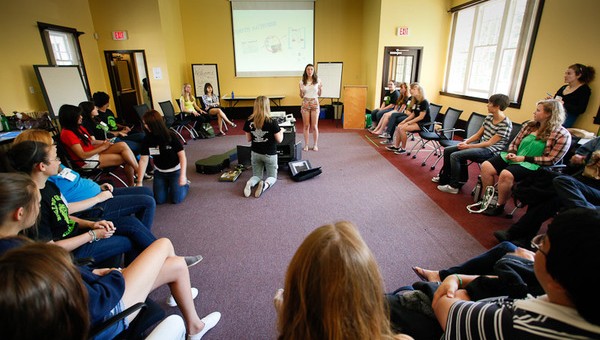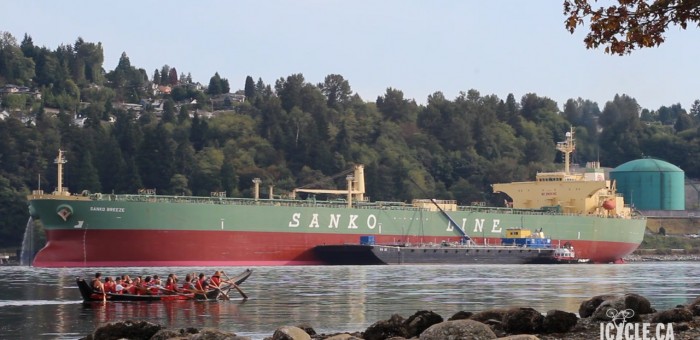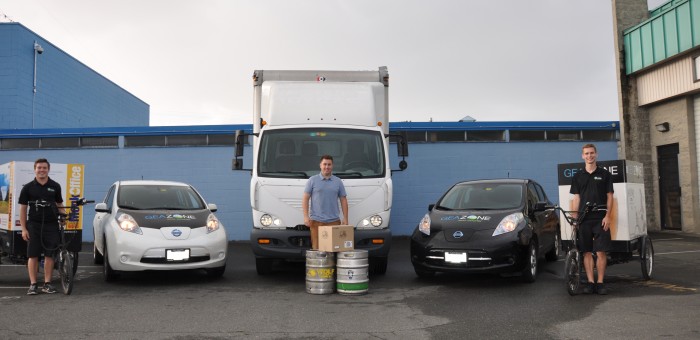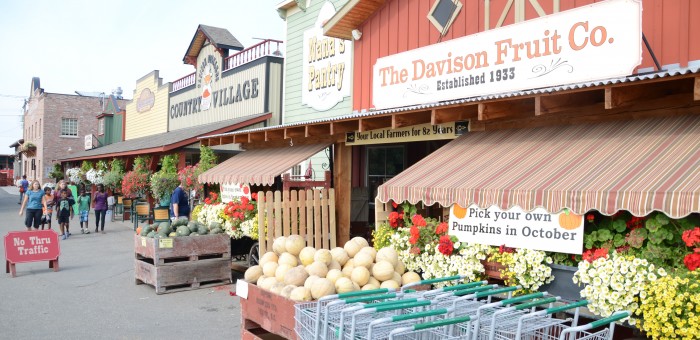Celebrating Queen Elizabeth II – longest serving Monarch
Text of my Opening Remarks
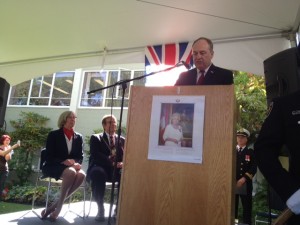 Your Honour, Mayor Jensen and Distinguished Guests:
Your Honour, Mayor Jensen and Distinguished Guests:
Today is a glorious day; one in which we recognize and honour the magnificent achievements of Queen Elizabeth II. Today, Queen Elizabeth II becomes the longest reigning monarch in British History.
Since Confederation in 1867, only six monarchs have ruled over Canada – Elizabeth II has been our Queen since she was 25 and for 43% of Canada’s history as a nation. I was not even born in 1953 when the Queen ascended the throne and my father, who marched in the Queen’s coronation procession with the University of Bristol Training Corps, was a twenty-year old undergraduate student.
During her reign, Elizabeth II has witnessed the election of twelve British Prime Ministers and eleven Canadian Prime Ministers (and possibly twelve a month from now). Eleven Governors General and twelve Lieutenant Governors of British Columbia have served as her representatives.
Canada has been the country most visited by The Queen throughout her reign of sixty-three years and, at eighty-nine years of age, the Queen still travels and keeps a full schedule of engagements.
Queen Elizabeth has participated in twenty-four Royal trips to Canada; She has often stated that it is her ‘second home’, feeling totally at ease in our wonderful nation. Here in Oak Bay we will never forget Her Majesty’s attendance at the 1994 Commonwealth Games. And Canucks fans across the province will recall her dropping the ceremonial puck (with Wayne Gretzky) at an exhibition game between the Canucks and the San Jose Sharks in 2002.
Her Majesty’s Canadian tours have included visits to each of the thirteen provinces and territories, frequently playing a key role in national celebrations and honour ceremonies. Though many of the Queen’s duties in Canada have been delegated to her Canadian representatives, she describes having a very deeply held affection for, and loyalty to, our country – which she first toured as Princess Elizabeth in 1951.
Our Queen is also a dedicated supporter of many Canadian charities and public organizations, such as the Canadian Cancer Society, the Canadian Nurses’ Association, the Canadian Red Cross Society, the Royal Canadian Humane Association, and Save the Children – Canada.
Elizabeth II has shown remarkable dedication and commitment in her role as our Queen. I am sincerely grateful to Councilor Hazel Braithwaite, Mayor Nils Jensen and the Municipality of Oak Bay for creating this opportunity to acknowledge and celebrate Queen Elizabeth’s tremendous accomplishments. Thank you for allowing me to participate in this historic event.
Long Live the Queen
Celebrating youth in our community – Ruby Tang
This is the 22nd in our series of stories celebrating the outstanding accomplishments of youth in our community. These inspirational young adults are enriching our lives with their passion and commitment to the betterment of society.
Ruby Tang
 Ruby was one of a group of students who visited my MLA office in April of this year. Across BC similar groups were visiting MLA offices asking MLAs to commit to do what they can to stop attempts to increase thermal (as opposed to metallurgical) coal exports through BC ports (I‘ve written extensively about this in the past). It was the first time I had the opportunity to meet and chat with Ruby and I was delighted to sign the pledge (and subsequently mount it and hang it in my constituency office). I was also profoundly impressed by her commitment and passion.
Ruby was one of a group of students who visited my MLA office in April of this year. Across BC similar groups were visiting MLA offices asking MLAs to commit to do what they can to stop attempts to increase thermal (as opposed to metallurgical) coal exports through BC ports (I‘ve written extensively about this in the past). It was the first time I had the opportunity to meet and chat with Ruby and I was delighted to sign the pledge (and subsequently mount it and hang it in my constituency office). I was also profoundly impressed by her commitment and passion.
Ruby is a multi-talented young woman who excels at school and is working towards the betterment of her community in so many ways. She was born in Victoria, attended Willows Elementary School and Monterey Middle School before attending Oak Bay High School. This week Ruby starts her final year in the newly built Oak Bay High School.
Ruby loves languages and learning about diverse cultures. Her parents immigrated to Canada from mainland China (near Guangzhou in Canton Province) when they were young adults. Ruby has studied at the Victoria Chinese Public School and speaks Mandarin and Cantonese. She received academic awards every year from 2009 to 2014 and a Chinese Painting Award in 2011. She remains closely affiliated to the school through acting as a grade one teacher’s assistant and (starting this fall) as an assistant in the Chinese water colour painting class. In addition, Ruby helps teach and rehearse Chinese cultural dance to younger students, aiding them to prepare for performances including the Chinese New Year celebrations and the Victoria Day parade.
 At the Victoria Chinese Public School, Ruby has taken a great interest in the history of Victoria’s Chinese community. She has been able to transcribe or transliterate from Chinese (Cantonese) to English and she helps out as a volunteer at the Royal BC Museum. Her volunteer duties have included doing research for the human history department at the Royal BC Museum.
At the Victoria Chinese Public School, Ruby has taken a great interest in the history of Victoria’s Chinese community. She has been able to transcribe or transliterate from Chinese (Cantonese) to English and she helps out as a volunteer at the Royal BC Museum. Her volunteer duties have included doing research for the human history department at the Royal BC Museum.
Ruby is a very accomplished musician. A student with the Victoria Conservatory of Music (VCM) since 2005, she has achieved the Royal Conservatory of Music (RCM) Grade 10 level in piano. She is currently working on achieving an Associate of the Royal Conservatory (ARCT) Diploma in piano performance. This is the highest academic standing for performance awarded by the Royal Conservatory. Included in her list of awards are the VCM Millicent Lavoy Piano Award (2014); the Hilda King RCM Theory Award (2013) and the VCM David Foster Piano Award (2011).
Ruby started learning to play the violin in Grade 5 and was in the School Districts’ Strings Program until Grade 10, enjoying many opportunities to perform at school concerts, during school tours, community performances and arts festivals.
 An exceptional student academically, Ruby has achieved a Grade Point Average of 5.0 with Distinction in Grades 9, 10 and 11 (averages above 90% each year). When we interviewed Ruby for this article, it was during the summer and she was attending summer school to complete English 12 – to get it done so there would be more time for the many activities Ruby will pursue in her graduating year. For example, she will be co-leading the Environment Club, participating in the Debate Club and continuing a project she is working on (and co-founded) with students from two other high schools called Victoria Youth Matters. The aim of Victoria Youth Matters is to “engage youth in politics and engage politicians in youth”. With a federal election coming in October, Ruby and the other co-founders will be holding all candidates forums for their local electoral ridings. The topics chosen would be based on a survey of youth’s understanding, interest and opinions on politics.
An exceptional student academically, Ruby has achieved a Grade Point Average of 5.0 with Distinction in Grades 9, 10 and 11 (averages above 90% each year). When we interviewed Ruby for this article, it was during the summer and she was attending summer school to complete English 12 – to get it done so there would be more time for the many activities Ruby will pursue in her graduating year. For example, she will be co-leading the Environment Club, participating in the Debate Club and continuing a project she is working on (and co-founded) with students from two other high schools called Victoria Youth Matters. The aim of Victoria Youth Matters is to “engage youth in politics and engage politicians in youth”. With a federal election coming in October, Ruby and the other co-founders will be holding all candidates forums for their local electoral ridings. The topics chosen would be based on a survey of youth’s understanding, interest and opinions on politics.
 Ruby has received many awards and accolades for her achievements at school and for her leadership and service to the broader community. In 2015, these have so far included being the Community Leadership and Philanthropy Pillar Representative at the Old School Farewell Ceremony, receiving the Oak Bay High Difference Maker Award, Best Overall Leadership Student Award and the Most Involved in the Community Award. In the community, Ruby received a District of Oak Bay Young Exceptional Star Award in 2014 and in 2015 she was the keynote speaker at the Young Exceptional Stars annual event.
Ruby has received many awards and accolades for her achievements at school and for her leadership and service to the broader community. In 2015, these have so far included being the Community Leadership and Philanthropy Pillar Representative at the Old School Farewell Ceremony, receiving the Oak Bay High Difference Maker Award, Best Overall Leadership Student Award and the Most Involved in the Community Award. In the community, Ruby received a District of Oak Bay Young Exceptional Star Award in 2014 and in 2015 she was the keynote speaker at the Young Exceptional Stars annual event.
 Ruby was Student Council Community Leader Representative in Grade 10 and Student Council Treasurer in Grade 11. Other school involvement includes the Cops for Cancer Campaign, Peer Tutoring and helping new students settle in at Oak Bay High. She has assisted the school counsellor by translating between English and Chinese (Cantonese and Mandarin) for new students (and their parents) from China. In Grade 12, Ruby will also lead the Amnesty International Club at her school.
Ruby was Student Council Community Leader Representative in Grade 10 and Student Council Treasurer in Grade 11. Other school involvement includes the Cops for Cancer Campaign, Peer Tutoring and helping new students settle in at Oak Bay High. She has assisted the school counsellor by translating between English and Chinese (Cantonese and Mandarin) for new students (and their parents) from China. In Grade 12, Ruby will also lead the Amnesty International Club at her school.
We are not sure where a person would find the time and energy to do more, but there is much more on Ruby’s plate. She has been very active in the Rotary Club’s International Action Club (known as Interact Club) at Oak Bay High. In Grade 11, as Interact Club President, she conducted meetings, organized events and worked on projects that benefited the school as well as projects that promote international goodwill. She was fortunate to attend a Rotary Youth Leadership Conference in Tacoma Washington in Grade 10, where she further developed leadership skills. In May 2015, Ruby took part in “Adventures in Citizenship”, an annual Interact program where 200 youth from across Canada travel to Ottawa to learn about the history of politics, explore Canadian identity and learn about our democratic institutions.
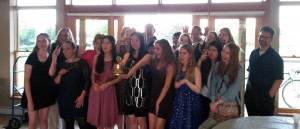 Ruby has been active in the community as a volunteer in many ways, including the Oak Bay Lodge “Memory Café”, where youth discuss topics of interest and share memories with senior citizens; the Victoria Dragon Boat Festival and the Oak Bay Tea Party. As I noted earlier, she has participated in the youth-led “Defend Our Future” action and she was part of the organizing team for the YesBC (Youth for Environmental Stewardship) 2015 Youth Climate Action Summit & Off the Grid Music Festival.
Ruby has been active in the community as a volunteer in many ways, including the Oak Bay Lodge “Memory Café”, where youth discuss topics of interest and share memories with senior citizens; the Victoria Dragon Boat Festival and the Oak Bay Tea Party. As I noted earlier, she has participated in the youth-led “Defend Our Future” action and she was part of the organizing team for the YesBC (Youth for Environmental Stewardship) 2015 Youth Climate Action Summit & Off the Grid Music Festival.
 To challenge herself, Ruby joined the girl’s school rugby team last year and found out that she loves the sport and she hopes to play in Grade 12. She has also been on the school’s badminton and cross country teams. She has a Bronze Cross in Lifeguard and Lifesaving from the Canadian Red Cross, including standard first aid and CPR training.
To challenge herself, Ruby joined the girl’s school rugby team last year and found out that she loves the sport and she hopes to play in Grade 12. She has also been on the school’s badminton and cross country teams. She has a Bronze Cross in Lifeguard and Lifesaving from the Canadian Red Cross, including standard first aid and CPR training.
In looking 10 years ahead, Ruby will have completed her post-secondary education and she hopes to be working on social justice issues in some way, possibly as a diplomat. When asked what makes her happy, she said “making a difference in people’s lives makes me happy”. She has been inspired by many people, including Mr. Alan York (recently retired as a counsellor at Oak Bay High) and Mr. Tim Bradshaw, Oak Bay High teacher, debate coach and sponsor of the school’s Rotary Interact club. Another person who has been an inspiration to Ruby is Winnifred Scott Wood, her past piano teacher.
Ruby is an outstanding ambassador for youth in so many ways. She’s highly motivated and organized and she takes on new challenges willingly. While she may accomplish so much and help so many, you would never know it from her quiet, modest and unassuming manner. Thank you, Ruby for all your contributions and hard work in your school and community. Oak Bay is a better place because of all that you do.
Serious questions must be asked about Trans Mountain Hearing Process
Media Release- September 3rd 2015
Serious questions must be asked about Trans Mountain Hearing Process
For Immediate Release
Victoria B.C. – After more than a year and a half, the National Energy Board (NEB) hearings for the Trans Mountain Expansion Project remain on hold as the previous deadline for final arguments passes. Andrew Weaver, MLA for Oak Bay Gordon Head and Deputy Leader of the BC Green Party is reiterating his call for the BC Government to establish it’s own review process.
September 3rd had been the deadline for intervenors to submit their final arguments for the NEB’s consideration under the old timeline. No new timeline has been established for when intervenors will submit their final arguments, or when the process will be resumed.
“My office prepared almost sixty pages of final arguments calling into question the evidence Kinder Morgan provided, especially around spill response.” said Andrew Weaver. “It is outrageous that once again the very impartiality of the process needs to be seriously debated. We’ve spent hundreds of hours operating under ridiculous time constraints reading thousands of pages of evidence to prepare our submissions and final arguments. The fact that in the eleventh hour the NEB is forced to put the hearing on hold points to the complete dysfunction of the current review process.”
The hearings were suspended by the NEB after Steven Kelly was appointed by Stephen Harper to the NEB in late July. Mr. Kelly is an energy consultant who was involved with preparing evidence that Kinder Morgan is in part relying on to justify the economics of their project,. This has set off a review by the NEB to identify the evidence that is connected to Mr. Kelly, striking any from the record that isn’t replaced by Kinder Morgan.
“The BC government is quick to suggest it’s five conditions are sufficient in ensuring that a project is in the best interests of British Columbians. ” said Andrew Weaver. “The fact is the five conditions can not, and do not act as a replacement for a rigorous process that allows for a diversity of intervenors to cross examine and test the evidence provided. I have lost confidence in the process. It is time for the BC Government to pull out of the equivalency agreement for this project and begin laying plans to initiate its own, rigorous review process.”
-30-
Media Contact
Mat Wright
Press Secretary – Andrew Weaver, MLA
Cell: 250 216 3382
Email: Mat.Wright@leg.bc.ca
Celebrating Local Businesses in Our Community – Geazone
 A four-time Canadian National Downhill Mountain Bike champion, Geazone’s president and CEO Andrew Mitchell is used to taking risks and working fast. “In downhill racing you have to live in the future, anticipating and preparing for what is around every corner on the trail,” said Geazone’s director of sales and marketing Greg Parish. When it comes to business, it seems Andrew takes the same approach.
A four-time Canadian National Downhill Mountain Bike champion, Geazone’s president and CEO Andrew Mitchell is used to taking risks and working fast. “In downhill racing you have to live in the future, anticipating and preparing for what is around every corner on the trail,” said Geazone’s director of sales and marketing Greg Parish. When it comes to business, it seems Andrew takes the same approach.
Geazone is a zero-emission courier company that uses tricycles, electric cars, and 5-tonne electric trucks to do their deliveries. On a full charge, Geazone’s electric fleet can deliver goods from Victoria to Nanaimo, and everywhere in between, without emitting a single gram of greenhouse gases. They do a Victoria to Vancouver run too, taking beer into the city and stopping to pick up hops for Victoria breweries on the way back.
Geazone presently has 100 active clients, many of them breweries, including Lighthouse, Red Arrow, Saltspring Island Ales, Wolf Brewing Company, and Hoyne. “The local beer and wine sectors seem to be the ones going green first,” said Andrew of his clients.
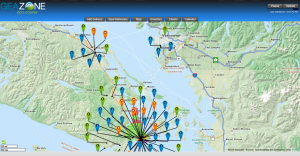 Over the course of this series it has been amazing to see so many B.C. entrepreneurs working together to support one another’s visions for business done better. When I met with Sean Hoyne, of Hoyne Brewing Company, he talked about how his brewery has partnered with Geazone to deliver their beer. “I like supporting Andrew because he is a young entrepreneur doing the right thing,” Sean told me. His praise was well deserved and wonderfully timed as I already had a meeting with Geazone booked for the following month.
Over the course of this series it has been amazing to see so many B.C. entrepreneurs working together to support one another’s visions for business done better. When I met with Sean Hoyne, of Hoyne Brewing Company, he talked about how his brewery has partnered with Geazone to deliver their beer. “I like supporting Andrew because he is a young entrepreneur doing the right thing,” Sean told me. His praise was well deserved and wonderfully timed as I already had a meeting with Geazone booked for the following month.
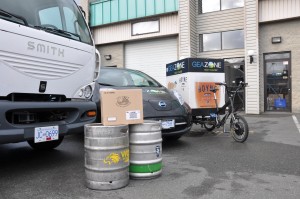 Geazone has doubled its growth every year since they opened for business in 2012. In just three years they have prevented over 100,000 kg of carbon emissions from entering the atmosphere and they don’t plan on slowing down anytime soon. Up next, they hope, is the addition of electric semi-trucks to their fleet (which can travel 160km/charge), a warehouse in Vancouver, and extra charging stations to broaden their range. “By the time people catch on we’ll be five years ahead,” said Greg.
Geazone has doubled its growth every year since they opened for business in 2012. In just three years they have prevented over 100,000 kg of carbon emissions from entering the atmosphere and they don’t plan on slowing down anytime soon. Up next, they hope, is the addition of electric semi-trucks to their fleet (which can travel 160km/charge), a warehouse in Vancouver, and extra charging stations to broaden their range. “By the time people catch on we’ll be five years ahead,” said Greg.
If Geazone replaced one of the semi-trucks delivering beer from Victoria to the British Columbia liquor distribution branch (BCLDB) in Vancouver with an electric model they would reduce carbon dioxide emissions on that route by roughly 37,000 kg per year.
Let’s take a look at the numbers:
- The round trip is about 140 km.
- The trucking industry vehicle fleets average 35-40 litres/100 km (so let’s choose 38).
- This means that on average a single round trip would use 140 km x (38 litres/100 km) = 53 litres of diesel (that would cost about $64 per trip at a price of $1.20 per litre).
- Now according to the US Energy Information Administration, 22.38 pounds of carbon dioxide are emitted during the combustion of one US gallon of diesel. This converts to 2.7 kg/litre.
- And so the average round trip in a diesel-powered truck would release 2.7 kg/litre x 53 litres = 143 kg of carbon dioxide emissions to the atmosphere.
- Now if we assume that only one trip can be made a day so that 260 trips occur each year with trucks operating only Monday through Friday, then in one year, 143 kg x 260 trips = 37,000 kg of carbon dioxide is emitted (and the annual cost of fuel would be $64 x 260 trips = $16,640).
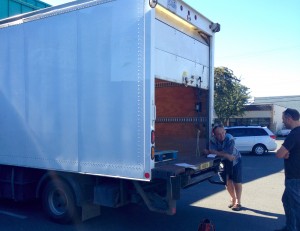
Cost-wise, their services are not more expensive than their diesel-reliant counterparts. If anything, Andrew said, they are more competitive than non-electric couriers because they don’t have to buy gas. Typical couriers will spend $80.00 or so on fuel per full day of deliveries; it costs Geazone $2.00 to charge up a Nissan Leaf for the day and $10.00 – $12.00 to charge their 5-ton trucks. Coming back to the numbers, the net annual operating savings on that return trip from Victoria to the BCLDB in Vancouver would be about $14,000 for a single truck.
That said, large courier companies do have the ability to undercut the market in a way Geazone cannot. But Andrew’s clients back him up, he said, and support Geazone because they believe in what he is doing.
The wider community in Victoria is getting on board too and the bike couriers are always a big hit at events and festivals, Andrew said. We found it amusing to learn that the Geazone team have been scolded on a few occasions by concerned citizens for leaving their trucks running while they load. “I told them it was electric but they didn’t believe me!” said Greg with a laugh. “I had to show them that the truck doesn’t even have an exhaust pipe — then they were impressed.”
Geazone is leading the way in BC with innovative zero-emission transport solutions. And at the same time, they’re saving money and creating job growth in the emerging 21st century economy.
Celebrating Innovation in Okanagan’s Agricultural Community
BC’s Agricultural Economy
Many of us take for granted the importance of agriculture in the BC economy. When combined with our seafood and food and beverage manufacturing, this so-called agrifoods sector contributes 1.9% of our provincial GDP.
When you look at farm cash receipts (the money received from the sale of agricultural commodities plus any direct program payments made to support or subsidize the agriculture sector), a whopping $2.8 billion flowed into the BC economy in 2013. According to statistics compiled by BC’s Ministry of Agriculture,
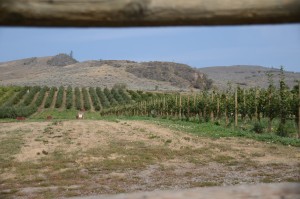 “Total farm cash receipts from the sale of crops, including grains, oilseeds, tree fruits, berries, grapes, field and greenhouse vegetables, floriculture, nursery, forage and other crops, amounted to nearly $1.4 billion in 2013, up 2.7 per cent over 2012 and up 12 per cent over the previous five year average. Total livestock receipts, from the sale of cattle, hogs, poultry, eggs, dairy, honey and other animals and animal products, amounted to more than $1.4 billion, up one per cent over 2012 and up eight per cent over the previous five year average.“
“Total farm cash receipts from the sale of crops, including grains, oilseeds, tree fruits, berries, grapes, field and greenhouse vegetables, floriculture, nursery, forage and other crops, amounted to nearly $1.4 billion in 2013, up 2.7 per cent over 2012 and up 12 per cent over the previous five year average. Total livestock receipts, from the sale of cattle, hogs, poultry, eggs, dairy, honey and other animals and animal products, amounted to more than $1.4 billion, up one per cent over 2012 and up eight per cent over the previous five year average.“
British Columbia also exports its agricultural products around the world. In 2013, agricultural exports amounted to $1.8 billion. Our top five export markets are: 1) United States [76%]; 2) China [4%]; 3) Japan [4%]; 4) Taiwan [2%]; 5) Hong Kong [2%].
What’s more, there were 19,759 farms in British Columbia in 2011, the last year for which census data are available, with 98 % of them being family-controlled farms and with over 54% of their farm operators being 55 years of age or older.
A conversation with Richard Bullock
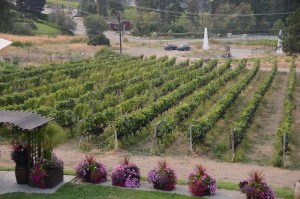 British Columbia is broken up into eight agricultural regions and last week I had the distinct pleasure of touring around the Okanagan region to meet with local civic leaders and business owners to get a sense of the opportunities and challenges facing the Okanagan.
British Columbia is broken up into eight agricultural regions and last week I had the distinct pleasure of touring around the Okanagan region to meet with local civic leaders and business owners to get a sense of the opportunities and challenges facing the Okanagan.
The Okanagan, has long been known for its tree fruit and grape production (and hence its wine industry), so what better place to start the tour than a meeting in Kelowna with, and at the family farm of, Richard Bullock, the past Chair of the Agricultural Land Commission. As the former president of the BC Fruit Growers’ Association, BC Tree Fruits Ltd., and Sun-Rype Products Ltd., and as a former Director of the Canadian Federation of Agriculture and Chair of the British Columbia Farm Industry Review Board, Mr. Bullock is certainly a wealth of information. He provided valuable advice concerning the need for Agricultural policies to be focused on the regional scale that reflect both the type and scale of producer. We also explored the importance of ensuring that water infrastructure, including reservoirs, keep pace with agricultural development as well as means and ways that smaller Okanagan tree fruit growers can compete against large-scale grow operations in other jurisdictions, such as Washington State.
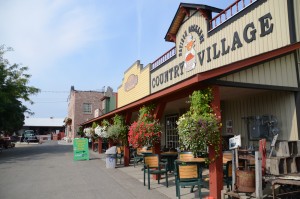 Mr. Bullock was extremely bullish on the agricultural industry in BC stating that he had “never seen the excitement in agriculture before in the last 10 to 15 years”. The numbers back up his sentiments. Agriculture exports increased by 12% in 2014 to $2 billion.
Mr. Bullock was extremely bullish on the agricultural industry in BC stating that he had “never seen the excitement in agriculture before in the last 10 to 15 years”. The numbers back up his sentiments. Agriculture exports increased by 12% in 2014 to $2 billion.
As I noted above, one of the challenges for Okanagan tree fruit growers is keeping fruit prices competitive with the larger growers in the United States and elsewhere. While the low Canadian dollar will surely provide a windfall for BC growers, other local farms have found innovative ways of ensuring that their business is resilient to market fluctuations. One of them, and one that I had the distinct honour of touring, is Davison Orchards Country Village in Vernon.
Davison Orchards Country Village
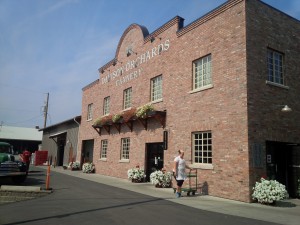 Davison Orchards has been in the Davison family since 1933 and it is now operated by Tom and Tamra Davison (the 3rd generation). Their children (Lance and Laura – the 4th generation) and Tom’s parents (Bob and Dora – the 2nd generation) all work on the farm. Davison orchards offers everything: producing food; capitalizing on tourism opportunities; selling produce and value-added food products (pies, jams etc.) directly to the consumer; offering a location to host private events. What’s more, their on-site café redefines what it means to live on a 100-mile diet as many of the menu items come directly from their farm.
Davison Orchards has been in the Davison family since 1933 and it is now operated by Tom and Tamra Davison (the 3rd generation). Their children (Lance and Laura – the 4th generation) and Tom’s parents (Bob and Dora – the 2nd generation) all work on the farm. Davison orchards offers everything: producing food; capitalizing on tourism opportunities; selling produce and value-added food products (pies, jams etc.) directly to the consumer; offering a location to host private events. What’s more, their on-site café redefines what it means to live on a 100-mile diet as many of the menu items come directly from their farm.
The Davison family is committed to the long-term sustainability of their land and their goal “is to produce fresh, high quality fruit and vegetables in a safe, sustainable and environmentally sensitive manner.” Several hundred thousand people a year visit the Davison orchards which employs upwards of 100 people during the May 1-October 31 season. Everything on the property is sold directly to consumers and the family also supports other farmers in the area by buying their produce and products and subsequently retailing them at their location.
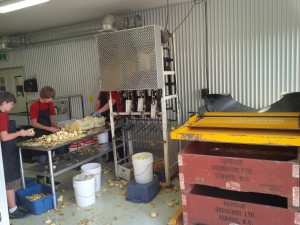 I was extraordinarily impressed at the innovation and creativity exhibited by Tom and Tamra, who gave me the tour of their property. They outlined how people move around from job to job to ensure they can offer stable employment opportunities. For example, the baker becomes the jam maker as the need arises. They also explained to me that it was tough for a small, ~100 acre orchard, to compete in the apple sector when over 100 million 18 kg boxes of apples are picked a year in Washington State just south of the border. But the remaining 1/3 acre of apples left in their orchard certainly allows them to offer visitors first-rate home-baked apple pies.
I was extraordinarily impressed at the innovation and creativity exhibited by Tom and Tamra, who gave me the tour of their property. They outlined how people move around from job to job to ensure they can offer stable employment opportunities. For example, the baker becomes the jam maker as the need arises. They also explained to me that it was tough for a small, ~100 acre orchard, to compete in the apple sector when over 100 million 18 kg boxes of apples are picked a year in Washington State just south of the border. But the remaining 1/3 acre of apples left in their orchard certainly allows them to offer visitors first-rate home-baked apple pies.
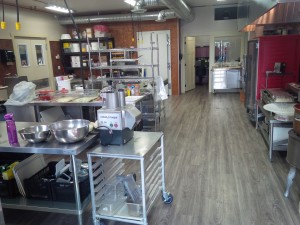 Davison Orchards has become one of the most visited tourist attractions in the area. In fact, Trip Advisor presently lists them as #1 of 35 things to do in Vernon based on 269 reviews earning them a Certificate of Excellence. And their Facebook page is continually updated with what’s in season, ongoing activities and interesting stories about the workings of the orchard.
Davison Orchards has become one of the most visited tourist attractions in the area. In fact, Trip Advisor presently lists them as #1 of 35 things to do in Vernon based on 269 reviews earning them a Certificate of Excellence. And their Facebook page is continually updated with what’s in season, ongoing activities and interesting stories about the workings of the orchard.
Davison orchards has figured out how to thrive through innovation. They’ve accomplished this by not only producing fresh and value added food products that they sell on site, but also through recognizing the tremendous opportunities in the tourism sector. The family-friendly atmosphere they have created means that there are fun things to do for everyone in a family — young and old. It’s a wonderful example of success in the agriculture industry.
Summerhill Pyramid Winery
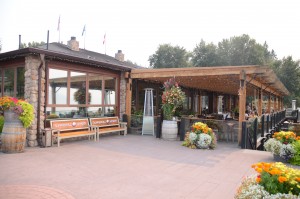 I was also delighted to have the opportunity to be taken around Summerhill Pyramid Winery by its CEO, Ezra Cipes. This allowed me to learn more about the Okanagan’s thriving wine industry.
I was also delighted to have the opportunity to be taken around Summerhill Pyramid Winery by its CEO, Ezra Cipes. This allowed me to learn more about the Okanagan’s thriving wine industry.
Summerhill Pyramid Winery is quite unique. It was Canada’s largest organic wine producer and BC’s first winery to receive (in 2012) Demeter Biodynamic certification. Established in 1991 on land purchased in 1986 by Ezra’s parents Stephen and Wendy Cipes, Summerhill comprises eighty acres of land of which only forty are planted with grapes. As part of the Demeter certification, twenty acres of the Summerhill property were placed under a restrictive covenant with The Land Conservancy of BC to ensure that biodiversity and natural habitat were protected. An additional twenty acres comprise meadows and composting areas.
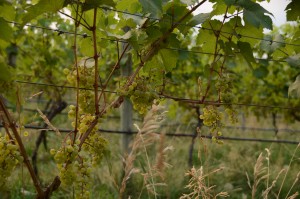 Winemaker Eric von Krosigk co-founded Summerhill in 1991 with the Cipes. He left temporarily in 1994 once the winery was up and running and rejoined Summerhill again in 2006. Ezra took over the day-to-day operations of Summerhill in 2008 and a year later, Summerhill Pyramid Winery was named Canadian Wine Producer of the Year at the International Wine and Competition in London, England. Today, Summerhill produces around 30,000 cases of wine a year, supports another 200 acres of other family-owned vineyards by buying their grapes, and supports around 40 full time employees. In 2014, they wrote paychecks for 270 people.
Winemaker Eric von Krosigk co-founded Summerhill in 1991 with the Cipes. He left temporarily in 1994 once the winery was up and running and rejoined Summerhill again in 2006. Ezra took over the day-to-day operations of Summerhill in 2008 and a year later, Summerhill Pyramid Winery was named Canadian Wine Producer of the Year at the International Wine and Competition in London, England. Today, Summerhill produces around 30,000 cases of wine a year, supports another 200 acres of other family-owned vineyards by buying their grapes, and supports around 40 full time employees. In 2014, they wrote paychecks for 270 people.
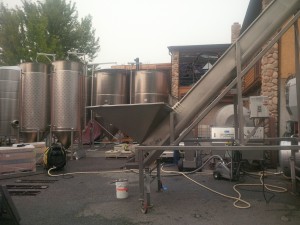 Like Davison Orchards, Summerhill has recognized the incredible opportunities in tourism and through offering value-added services (a restaurant and a location for wedding receptions). Fully 55% of Summerhill’s wine is sold on-site with 2,000 cases passing through their restaurant and wedding reception operations.
Like Davison Orchards, Summerhill has recognized the incredible opportunities in tourism and through offering value-added services (a restaurant and a location for wedding receptions). Fully 55% of Summerhill’s wine is sold on-site with 2,000 cases passing through their restaurant and wedding reception operations.
Summerhill takes tourism seriously. When we arrived at Summerhill Pyramid Winery last Tuesday, the parking lot was full and a bus load of Asian tourists were admiring the beautiful views of Lake Okanagan. They have fully restored a cabin used by one of the original settlers to the area and built a replica of a scared earth First Nation house nearby (unfortunately this was being renovated when we visited). In addition, a nature/historical walk was being prepared through their property.
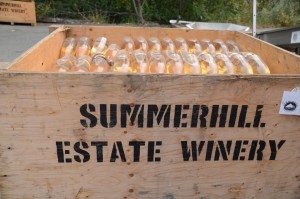 It should be no surprise to find out that Summerhill also received a Certificate of Excellence from Trip Advisor. But of course, and most importantly, the wine was exceptional. In the end I bought a bottle of 1998 Cipes Ariel after sampling it at the winery. The Vancouver Sun has described this as “one of the finest sparkling wines ever made in British Columbia” and I can certainly attest to it being perhaps the finest I have ever tasted.
It should be no surprise to find out that Summerhill also received a Certificate of Excellence from Trip Advisor. But of course, and most importantly, the wine was exceptional. In the end I bought a bottle of 1998 Cipes Ariel after sampling it at the winery. The Vancouver Sun has described this as “one of the finest sparkling wines ever made in British Columbia” and I can certainly attest to it being perhaps the finest I have ever tasted.
Summary
Echoing the words of Richard Bullock, it’s an incredibly exciting time for agriculture in British Columbia. We have enormous potential to continue to grow our agricultural sector in the years ahead both through the direct production of food and, as demonstrated by the two successful examples of innovative and creativity that I highlight above, through developing and offering value added food products and services (including tourism). But as the climate continues to warm as a direct consequence of increased atmospheric loading of greenhouse gases, we have to be careful to ensure that this industry has the capacity to adapt to the changing climate. As this past summer has demonstrated, a warming climate has many potential benefits for British Columbia’s agricultural sector in the short term but, without adequate access to freshwater for irrigation, trouble looms ahead.
Global warming will bring a water storage, not a water shortage problem. Overall precipitation will increase, but it will come in fewer, more extreme events, interspersed between longer periods of little or no precipitation. There will be an increased risk of flooding. The precipitation will be skewed to the winter, with a greater likelihood of rain instead of snow as the century progresses. And summer drought will become more common. There will be lots of water around, but it will come at times when it’s not needed and not at times when it is needed. But with proper foresight, adaptive planning and reservoir management, British Columbia should be well positioned to successfully nurture and sustain its vibrant agricultural sector and communities.


